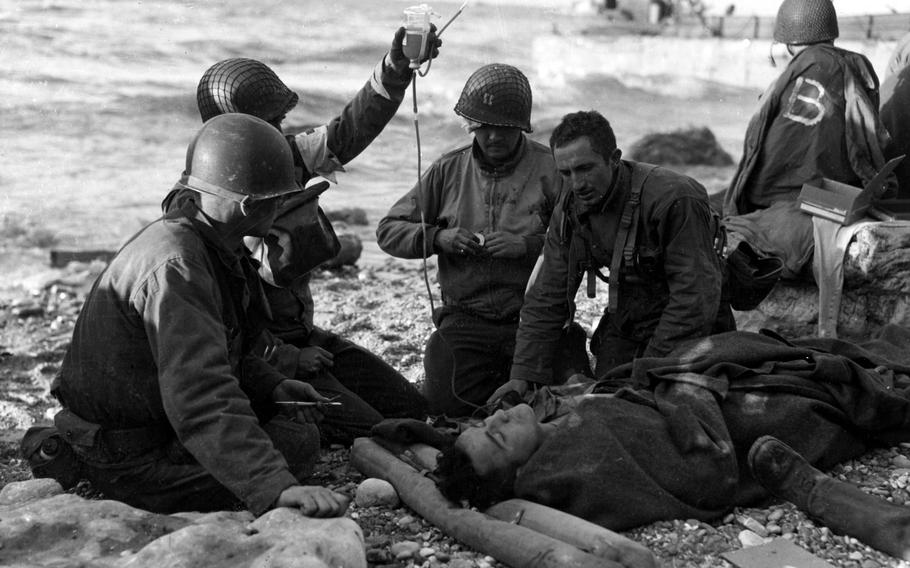
Nurses administer a plasma transfusion to a wounded survivor of a landing craft at ''Fox Green'' sector portion of Omaha Beach. The Soldiers are from the 16th Infantry Regiment, 1st Infantry Division. (Louis Weintraub/U.S. Signal Corps)
Soon thousands of combat veterans, treasured foreign allies and active service members will surge into northwestern France to honor one of civilization’s most somber and exceptional military marvels: the D-Day invasion of June 6, 1944.
Eighty years have passed since troops from America, the United Kingdom, Canada and 10 additional allied nations launched history’s largest amphibious invasion into well-fortified, difficult-to-reach enemy territory with no feasible escape plan.
The operation’s success — and the course of global freedom and security that has followed — is a testament to its planners’ insights, its leaders’ boldness and most of all its fighters’ tenacity. An invasion of this scale, lethality and surprise had never been so technologically possible in the years before 1944, and may never again be so strategically practical.
The dual victory and tragedy of D-Day remains unique in human history. And as America’s population of living World War II survivors dwindles below 1%, this 80th anniversary stands out as perhaps the final major milestone where America’s leaders and future leaders may personally connect with — and thank — the invasion’s survivors.
In the days and weeks leading up to the June 6 anniversary, the seaside communities of Normandy prepare for an influx of World War II veterans returning to French soil, global friends and new generations of allies. In village centers, on battlefields and beaches and within sprawling, delicately maintained international cemeteries, guests will sit in silence, mourning and meditation for the lives lost on that very soil. Here in the U.S. — and anywhere we enjoy freedom, democracy and progress — we must strive to do the same: reflect on the tolls of a world war, and on the unrelenting strength and selflessness of America’s warfighters.
As chairman of the American Battle Monuments Commission; a U.S. Army veteran with nearly 40 years of service; and the son, husband and father of Army combat veterans and spouses, D-Day and its impact on the world captures my attention and my heart.
I recognize, however, that most Americans do not share such military links. Through no fault of their own, modern people living modern lives may find little direct relevance in the impossible bravery of strangers in uniform — heroes, but strangers nonetheless — in a distant land a lifetime ago.
But maybe — with our alliance at the edge of a world war once again, while American enthusiasm to serve in an all-volunteer force wanes — maybe the stories surrounding D-Day are more important than we think.
The Department of Defense reports that during its last fiscal year, the military services collectively missed recruiting goals by about 41,000 recruits. This year, our active force will be the smallest since 1940 — the same year the U.S. enacted its first peacetime draft to fill our ranks ahead of a looming war. Meanwhile, a February Pew Research report found just over half of adults under the age of 30 — our military services’ primary recruiting demographic — have a negative perception of the U.S. military.
Logically, images from one of America’s bloodiest battles seem unlikely to send young Americans sprinting toward the nearest recruiting station. However, the lesson we ought to learn from D-Day is not one of self-preservation, but of national identity.
D-Day — and its fellow defining battles across American history — illustrate the stakes, the resources and the will that it takes for a fighting force to win, when a loss (or failure to act) threatens borders, democracies, innocence and history.
The 31 monuments and more than 200,000 service members honored by the ABMC across 17 foreign nations — with more sites in France than any other — stand as a testament to the cost of national and international will. Monuments, museums and written and oral histories are our first and most immersive entry points into the battles that have helped ensure the American values we enjoy today.
Let this 80th anniversary of D-Day begin or renew a spirit of learning for you, your loved ones, your classrooms and your teams. Firsthand accounts and artifacts are widely documented online and available across America’s national and military history museums. Veteran memorials stand in our communities. The American flag is waving nearby. Each presents at least a moment for reflection.
As students of war and fighters for peace, your U.S. military may never stop studying D-Day and its overarching operation, code-named Overlord, for strategies and inspiration to apply toward today’s formations. These were hard-won lessons. Likewise, our national strength, global alliances and long-term freedom were hard-won by Americans like you and I, a mere 80 years ago.
Let us never forget.
Michael X. Garrett, a retired U.S. Army general, was appointed chairman of the American Battle Monuments Commission by President Joe Biden in 2023. He served 38 years in the Army, finishing his tenure as the commanding general of United States Army Forces Command in 2022.